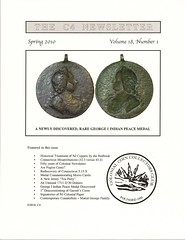
About UsThe Numismatic Bibliomania Society is a non-profit organization promoting numismatic literature. For more information please see our web site at coinbooks.org SubscriptionsThose wishing to become new E-Sylum subscribers (or wishing to Unsubscribe) can go to the following web page link MembershipThere is a membership application available on the web site Membership Application To join, print the application and return it with your check to the address printed on the application. Membership is only $15 to addresses in the U.S., $20 for First Class mail, and $25 elsewhere. For those without web access, write to: David M. Sundman, Secretary/TreasurerNumismatic Bibliomania
Society AsylumFor Asylum mailing address changes and other membership questions, contact David at this email address: dsundman@LittletonCoin.com SubmissionsTo submit items for publication in The E-Sylum, just Reply to this message, or write to the Editor at this address: whomren@coinlibrary.com
BUY THE BOOK BEFORE THE COINYou won't regret it! |
- WAYNE'S WORDS: THE E-SYLUM MAY 30, 2010
- KOLBE & FANNING STACK'S LIBRARY II SALE CLOSES JUNE 3, 2010
- SKLOW MAIL BID SALE #10 CLOSES JUNE 12, 2010
- BALDWINS STRICKLAND NEVILLE ROLFE COLLECTION SALE RESULTS
- NEW BOOK: THE TOKEN BOOK: BRITISH TOKENS OF THE 17TH, 18TH AND 19TH CENTURIES
- NEW BOOK: WATERCRAFT ON WORLD COINS, VOL. II: AMERICA AND ASIA, 1800-2008
- NEW EDITION: THE 2011 STANDARD CATALOG OF WORLD COINS 1901-2000
- BANKNOTE DESIGNER HARRY ECCLESTON, 1923-2010
- NUMISMATICA MEDIEVALIS: SPECIAL FONT FOR DESCRIBING MEDIEVAL COINS
- THE SPRING 2010 C4 NEWSLETTER PUBLISHED
- MORE ON HARZFELD'S "OLD COINS AND THEIR VALUES"
- MYSTERY NUMISMATIC ANIMAL UNVEILED
- MYSTERY NUMISMATIST: "YN OF THE CENTURY"
- NOTES FROM E-SYLUM READERS MAY 30, 2010
- VIDEO PRESENTATIONS ON THE 1913 LIBERTY NICKEL
- THE COLUMNS OF THE THIRD PHILADELPHIA MINT
- SUBSCRIBER PROFILE: HEATH MACALPINE
- MORE ON HOWARD D. GIBBS
- HOWARD FRANKLIN BOWKER
- WHERE KRAUSE NUMISMATIC PUBLICATIONS WERE PRINTED
- SPANHEIM'S DISSERTATIONES AND OTHER EARLY NUMISMATIC LITERATURE
- DICK HANSCOM VISITS THE NEWBURYPORT JACOB PERKINS BUILDING
- 21ST CENTURY NATURE PRINTING: SCIENTISTS STUDY BUTTERFLIES
- PCGS TAKES AIM AT COIN DOCTORS
- NEW NONDESTRUCTIVE METHOD FOR ANALYZING ANCIENT COINS
- FINEST 1794 DOLLAR SALE PUBLICITY
- DENVER TOUR HIGHLIGHTS 1922 U.S. MINT ROBBERY
- ARTICLES DISCUSS ABOLISHING THE CANADIAN CENT
- ARTICLE: CHINESE COUNTERFEITS PEDDLED AT LOCAL COIN SHOW
- READER NOTES ON CHINESE COUNTERFEITS
- FEATURED WEB SITE: COIN SHRINKING
WAYNE'S WORDS: THE E-SYLUM MAY 30, 2010

Among our new subscribers this week is Jay Williamson, courtesy of Dick Hanscom. Welcome aboard! We now have 1,343 subscribers.
Happy belated birthday to Eric Newman, who turned 99 on May 25. I gave him a call that afternoon, and he's still as sharp as ever, and working on numismatic research. He's a regular E-Sylum reader who finds at least three or four articles of interest in every issue.
This week we open with reminders of two upcoming numismatic literature sales, results from a recent Baldwin's sale, and announcements of three new books.
Other topics include banknote designer Harry Eccleston, Chinese coin researcher and collector Howard Bowker, and an unusual tour related to the Denver Mint.
To learn about numisnautical research, butterflies, coin shrinking, and the whereabouts of the columns from the façade of the third Philadelphia Mint, read on. Have a great week, everyone!
Wayne Homren
Numismatic Bibliomania Society
KOLBE & FANNING STACK'S LIBRARY II SALE CLOSES JUNE 3, 2010
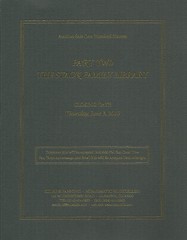 Kolbe & Fanning Numismatic Booksellers remind bidders that the sale of the second part of the Stack's library will close on Thursday, June 3. Telephone bids will be accepted until 6:00 p.m. Eastern Time, with fax and email bids accepted through midnight.
Kolbe & Fanning Numismatic Booksellers remind bidders that the sale of the second part of the Stack's library will close on Thursday, June 3. Telephone bids will be accepted until 6:00 p.m. Eastern Time, with fax and email bids accepted through midnight.
Due to complications with our mail delivery, we would ask that bidders who sent their bids in via regular mail confirm with us that they have been received if we have not been in contact with them. Bids may also be submitted via email to df@numislit.com, by phone at (614) 414-0855 and by fax at (614) 414-0860.
SKLOW MAIL BID SALE #10 CLOSES JUNE 12, 2010
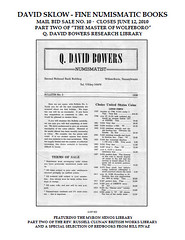 My Numismatic Literature Mail Bid Sale # 10 closes Saturday June 12th.
There is still time to submit your bids; Via Email, Fax, USPS & Phone.
Phone bids are accepted until 8pm [MT] on closing day
Email, Fax and bids left on our answering machine are accepted until Midnight on closing day.
My Numismatic Literature Mail Bid Sale # 10 closes Saturday June 12th.
There is still time to submit your bids; Via Email, Fax, USPS & Phone.
Phone bids are accepted until 8pm [MT] on closing day
Email, Fax and bids left on our answering machine are accepted until Midnight on closing day.
David Sklow-Fine Numismatic Books
P.O. Box 6321
Colorado Springs, CO 80934
PH: 719-302-5686
FAX: 719-302-4933
EMAIL: numismaticbooks@aol.com
WEB: FineNumismaticBooks.com
BALDWINS STRICKLAND NEVILLE ROLFE COLLECTION SALE RESULTS
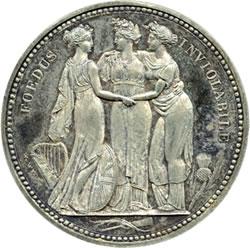 The Strickland Neville Rolfe collection is an amazingly conserved compilation of Ancient, British and World coins, tokens and Commemorative medals that has been untouched and out of circulation since 1852.
The Strickland Neville Rolfe collection is an amazingly conserved compilation of Ancient, British and World coins, tokens and Commemorative medals that has been untouched and out of circulation since 1852.
This numismatic collection has remained in the hands of Rolfe's descendents since his death and brilliantly represents a snapshot of the tastes and interests of an educated English country gentleman and divine of the Victorian era.
Strickland Charles Edward Neville Rolfe was born in 1789, eldest son of General Neville of the Royal Artillery. He assumed the name and arms of Rolfe by royal warrant in 1837, upon receiving the bequest of the estates at Heacham and Sedgeford, from Edmund Rolfe, a distant relative who had no issue.
The English coins from the collection span three centuries and include some key rarities, such as the pattern "Incorrupta" crown (lot 1405), one of only eighteen known to have been struck, and the "Three Graces" crown, one of the most important and majestic coins of the English series (lot 1406).
Both the "Incorrupta" and the "Three Graces" crowns were struck by the renowned medallist, William Wyon. Wyon was born into a family of engravers and medallists and was the official Chief Engraver at the Royal Mint from 1828 until his death in 1851. He is well known amongst the numismatic community for the prolific amount of work he produced and for his artistic ability.
There were Rolfes amongst the early settlers in America, notably as successful Virginia tobacco farmers and amongst the colonial coins are some superb early American coins. Most notably a pewter Continental Dollar (lot 1589), some stunningly preserved Rose Americana coppers (lots 1590-1593), and a magnificent Virginia halfpenny (lot 1594).
Perhaps the most extraordinary part of the collection is the series of Norfolk and Suffolk 17th Century tokens (lots 1474-1486). This is a substantial collection of 365 pieces, formed with obvious pride and dedication, as is confirmed by the meticulous notebook kept by Rolfe for the Norfolk part.

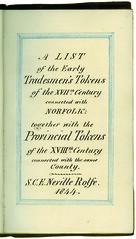
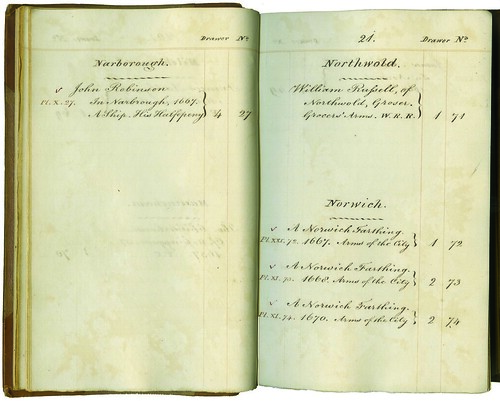
Whether he drew the astonishing pen and ink illustrations himself, or employed an artist to do them, we will never know. There are numerous rarities for both counties, many in remarkably high grade. The sobering thought is that this collection was unknown to the key researchers and cataloguers of this series in the 19th and 20th Centuries, William Boyne (1858), George Williamson (1889) and latterly, Michael Dickinson. The tokens listed in the notebook will be sold with it in one lot, to maintain the integrity of the collection.
The sale, which included part one of The Michael Hall Collection, The Bishop's Wood Hoard of Roman Coins and The Strickland Neville Rolfe Collection attracted 846 different bidders over the two days and achieved some exceptional individual results.
The Bishop's Wood Hoard of Roman coins was amongst the lots in the Ancient section which opened the second day of the sale. The 1,661 coins and the restored jar that contained them were sold in 10 lots including the purpose built cabinet in which they were housed. The lots drew worldwide interest amongst the ancient numismatic community prior to the auction as the coins had remained uncirculated and had been in the family of the landowner since their discovery in 1895. In total the 10 lots (lots 1152-1162) achieved £46,964. The lots were all won by the same bidder so we are very happy to report that this part of the hoard remains intact.
The most notable lots included key rarities, such as the pattern “Incorrupta” crown (lot 1405), one of only eighteen known to have been struck, and the “Three Graces” crown, one of the most important and majestic coins of the English series (lot 1406), which sold for £25,960 and £29,500 respectively against estimates of £10,000-£15,000. Lot 1452, an undated Charles II, St. Patrick's coinage Farthing, achieved an exceptional hammer price of £3,776.
Lot 1474, a collection of 239 Norfolk 17th Century tokens, complete with accompanying notebook, sold well over estimate for £14,750. The notebook itself pre-dates any of the reference works on which we rely today and exposes Rolfe as somewhat of a pioneer in this field, which is sure to have contributed to the excellent result achieved for the lot. By far the most compelling piece in the collection was a stunningly preserved 1776 Continental Dollar (lot 1588, pictured above) which sold in the room for a staggering £63,720.
To read the earlier E-Sylum article, see: BALDWINS TO OFFER STRICKLAND NEVILLE ROLFE COLLECTION (www.coinbooks.org/esylum_v13n15a19.html)
NEW BOOK: THE TOKEN BOOK: BRITISH TOKENS OF THE 17TH, 18TH AND 19TH CENTURIES
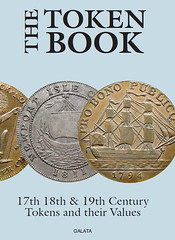 THE TOKEN BOOK. 17th, 18th & 19th century British tokens and their values by P & B R Withers. 14 x 22 cm 512 pages, over 3000 tokens illustrated, all in colour, from the best specimens in public and private collections. £48 (+ £4.50 p&p)
THE TOKEN BOOK. 17th, 18th & 19th century British tokens and their values by P & B R Withers. 14 x 22 cm 512 pages, over 3000 tokens illustrated, all in colour, from the best specimens in public and private collections. £48 (+ £4.50 p&p)
There is a 20-page introduction with a short account of how to understand tokens, and a list of the standard reference works for each main type. Nearly 3500 17th century tokens are listed, with Williamson/Dickinson reference numbers, and prices for Fine condition. Over 2,500 of these are illustrated, including the most commonly found pieces, the most interesting, those that are heart-shaped, square, hexagonal or octagonal, and those depicting the tools and products of various trades and activities, inn signs, and the arms of the livery companies.
- For each county there are details of the token-issuing towns, cities and villages with the number of tokens they issued.
- 18th century tokens listed with Dalton & Hamer references, all types listed, with edge varieties, and prices for up to three grades. Gives more information and has many more illustrations than the Schwer guide.
- 19th century silver tokens listed with Dalton references. All types listed, prices for EF condition.
- 19th century copper tokens listed with Withers references. All types listed, prices for three grades.
- Evasion halfpennies and farthings listed with Atkins references, prices for fair or Fine condition.
- Select bibliography.
- Detailed index with around 2000 entries.
We first thought of the project almost two years ago when we asked various people whether they thought there was a need for a new pricing guide to tokens. The answer, both from collectors and most dealers was a resounding “yes !” The general response being that new people are coming to the hobby and need guidance and literature to help them find their way. The only guides currently available are all 25 years old.
As a healthy, active segment of the market is located in the USA we discussed the project with Allan Davisson, who is part of that market, and also has a high reputation among dealers here in the UK. He was very helpful, and we subsequently got a lot of help from Bill McIvor too.
Back in 1970 B A Seaby published British Tokens and the Values. It was popular with collectors and dealers alike, indeed, a lot of people are still using it ! The book was reprinted with revisions in 1984. Around the same time, Fred Schwer printed his Price Guide to 18th Century Tokens, and, a year later, Michael Dickinson produced his excellent Seventeeth Century Tokens of the British Isles.
Since then, although inflation has been rampant and also the market has grown and matured, there has been nothing more of a similar nature published; so, a quarter of a century on, demand for an up-to-date price guide is quite legitimate given that some of the books are now only obtainable secondhand, and that prices have increased due to demand, and inflation.
As numismatic book dealers we get many requests for the old works whenever we have them for sale, and the 1984 revision of British Tokens and their Values sells on eBay for around £45 (60$) and we could never find enough copies of Fred Schwer's book to supply the demand.
What is needed in such a new work ? Not only does it need to reflect the current market as closely as possible but we decided to correct errors in previous works, and also those that we had spotted in the original standard reference works, particularly where attributions have been revised when research has shown this to be necessary.
We also used the opportunity to add lots of illustrations, so that this has become the best illustrated book on 17th century tokens that there is, especially for those of Ireland. In some instances, where suitable examples were not available for photography, we have used line drawings. These were obtained from George Benn: A History of the Town of Belfast, 1877, and Thomas Snelling's A view of the Copper Coin and Coinage of England, published in 1766, the very first guide to tokens.
For the shields of arms of the London livery companies we went back to William Boyne's 1858 Tokens issued in the Seventeenth Century, and discovered that if we really tried hard, we could produce passable results ourselves for those that we needed that were not in Boyne. Numismatics is certainly a hobby that extends one and requires the development of new (old) skills !
Incidentally, thinking of old works, we used James Atkins' The Tradesmen's Tokens of the Eighteenth Century for checking back on Dalton & Hamer, and found it to be instrumental for giving the answers to many little puzzles and problems. It should neither be ignored nor consigned to the stack just yet.
The 18th century section is clearly not as well illustrated, nor as detailed as D&H itself; obviously so, as D&H is a BIG book, and we wanted this be a handbook, not something the size of a family bible. It is, however, rather better illustrated than Schwer, and the text a lot more detailed. D & H is currently out of print, so those that can't find a copy, or can't afford it, will find this a find this the best substitute available.
We have, however, left some things undone and would like to point them out - the 18th century tokens of Ireland section is something that an enthusiastic expert needs to take on board and look at afresh. Judging by the last few editions of “Conder” Gregg A Sylvis has clearly started on such a project. Anglesey too is in need of an overhaul, D & H didn't do a bad job on it, but it could be simplified a bit, and with modern electronic techniques, arrows could be applied to the photographs to point out where the extra acorns are !
The last quarter century or so has been a remarkable period for token collectors. There has been a great increase in interest in 18th century tokens and in the number of collectors. It really started with Spink selling the collection of T A Jan in 1983 and 1984. When R C Bell's collection was sold by Dix Noonan Webb (DNW) in 1996, 18th century tokens were beginning to look up, but 19th century copper tokens were in the doldrums and we bought most of what we wanted with little opposition.
In 1998, Jim Noble sold his collection of tokens and paranumismatica. The catalogue was a real blockbuster which brought to an international market a critical mass of material which had not been seen for a quarter of a century or more, some of it with pedigrees going back to those doyens of the token world S H Hamer and W J Davis, and other famous names.
In 2000, the new century started with a metaphorical bang, when Allan Davisson brought Wayne Anderson's collection to the market, setting many price records, largely because the material was choice.
Since then DNW have offered the collections of Joel Spingarn, David Litrenta and David Spence, the last two of which required no fewer than three catalogues each.
In the last year or so, prices for general 18th century material seem to have fallen a little from the heights they were achieving two years before, though rarer and choice material has continued to rise in price due to demand. Over the past two years prices for 19th century copper tokens in high grade, especially those with original red lustre, have risen sharply too, but that market is by no means as sophisticated as that for 18th century tokens.
Spectacular prices for choice material are one thing, but the lower end of the market is strong too, with badly worn and damaged items making prices in Internet auctions that sometimes make one gasp and stretch one's eyes.
Unaware, non-discriminating buyers clearly do not realise that much better buys may be available elsewhere ! This does, however, set the scene for the lower end, and it is part of the market, albeit one that most established dealers will not reach, largely because many of its denizens keep out of the light.
For the last nine months we have expended thousands of hours compiling the book, and apart from fine tuning it is now more or less ready for the press. In the words of the computer-savvy generation, the Beta versions have gone out. Prices, repricings, corrections and additions are coming back from collectors.
The neophyte probably wonders exactly how one values a coin or token. I certainly did when I was young. If you are an expert you look at the piece and put a price on your ticket. If you are not, then you have to resort to a guide, especially if you are a new collector who wants to find out what he should pay at auction, or decide whether the price being asked by a dealer is a bargain, a rip-off, or just right.
A true price is said to be that arrived at after negotiations between a knowledgeable buyer and an informed seller. How often that actually happens is uncertain, but what is certain is that there are trends which become evident when observing the market closely over a period of a decade, or longer.
Punters at race courses assessing a horse's likelihood of winning examine its ‘form', i.e., how the nag did the last time out, though other matters also have to be taken into condition – the skill of the jockey riding it, whether the going is hard or soft, the trainer, the course, the weather, the opposition and whether the leprechauns are with you that day, or not. The market in tokens is a bit like that, it is essential to know how pieces of the same type performed the last time they came up for auction and prices are based on that sort of information.
Auction results, however, have to be interpreted with care, for although they do give an instant snapshot of the market at that time, and are evidence of a wider picture if taken over a period of a decade or more, some things sometimes do not make nearly enough, or when two wealthy collectors are competing it has been known for one of them to commit financial suicide.
So, the prices we have put in our book are not derived solely from auction results, but dealers' offerings, our experience and observations. We have assessed, wherever possible, the rarity, and precise condition, which is not easy considering that some dealers can be mildly mendacious and others unduly hype what they are selling. We have accordingly recorded pieces only where illustrations were available to us, and/or where we knew the standards of the cataloguer.
The market for 18th tokens is not one theatre of action. There are those customers (mainly in the USA) who want perfection, and those in the UK who are satisfied with extremely fine pieces, who frankly do not care overly much whether their piece has red colour or not. Then there are those who frequent coin fairs but who are happy with pieces in VF condition and have never seen an auction of choice and rare material, and then there are those who buy solely from on-line auctions and only see a bright, shiny red colour when the piece they are buying has been pickled in battery acid.
Add to that people who buy tokens because they are interesting, historical relics, and even then you don't have the complete picture, so someone entering this world needs a price guide to help them. I know that I did, and still do, and I have been a dealer now for coming up to 50 years. In other words, I shall be using our own guide !
The 19th century copper tokens is a modified version of our own book. Only the major types are listed so as to cut it down to size. There are many illustrations, all taken from examples in our own collection. We have done much the same for the 19th century silver tokens, using Dalton's work as the basis. The illustrations were from pieces owned by an English collector, and Allan Davisson.
The illustrations for 17th century tokens were taken from several collections, public and private, including those of several collectors who preferred to remain anonymous.
So forgetting the slabbers and the elitists, our new price guide is a book to help the collector to know where he is, a road map of an enormous continent, to show where the fun is. It will give you a price without you having to spend hundreds of hours trawling through world auctions to find out what price your token made the last time it came up for sale.
It puts the collector in charge of his own destiny by telling him how much he is likely to have to pay for the nice, the very nice or the extremely nice piece he wants, and if he wants a diamond-sharp, bright red piece of perfection there are sufficient examples of similar items to warn him what that's likely to cost too.
NEW BOOK: WATERCRAFT ON WORLD COINS, VOL. II: AMERICA AND ASIA, 1800-2008
 The book is organized as a catalog of “ship coins” according to the popular KM-numbering system. Coins that have a common design are grouped under separate headings. Included are both circulating coins and collector oriented commemoratives. The coin images represent the many different ways in which the ships are depicted. Volume II includes more than six hundred narratives, and follows on from the publication of Volume I, Europe, 1800– 2005 ( 2007), acclaimed as a book that should be owned or at least read by every collector of world ship coins. A third volume, presenting ship coins issued by nations in Africa and Oceania, is planned for publication in 2013.
The book is organized as a catalog of “ship coins” according to the popular KM-numbering system. Coins that have a common design are grouped under separate headings. Included are both circulating coins and collector oriented commemoratives. The coin images represent the many different ways in which the ships are depicted. Volume II includes more than six hundred narratives, and follows on from the publication of Volume I, Europe, 1800– 2005 ( 2007), acclaimed as a book that should be owned or at least read by every collector of world ship coins. A third volume, presenting ship coins issued by nations in Africa and Oceania, is planned for publication in 2013.
ABOUT THE AUTHOR
Yossi Dotan is a numisnautical researcher, a recognized expert in modern coins depicting watercraft. Since retirement after a 46-year career with a major firm of certified public accountants, he has devoted himself to researching ships and coins, and writing the narratives for this book. He is a contributor to the Standard Catalog of World Coins. In recognition of his non-numismatic volunteer service, Queen Beatrix of The Netherlands has made him a Knight of the Order of Orange-Nassau.
RELEASE DATE: June 2010
PAPERBACK PRICE: £49.50/$79.95
EXTENT / FORMAT: 360 pp. 246 x 171 mm
Illustrated with 500 coin images, throughout
PUBLISHER: THE ALPHA PRESS
TELEPHONE: +44 (0)1323 479220
EMAIL: edit@sussex-academic.co.uk
To read the E-Sylum review of Volume I, see: REVIEW: WATERCRAFT ON WORLD COINS, VOLUME I BY YOSSI DOTAN (www.coinbooks.org/esylum_v10n45a05.html)
NEW EDITION: THE 2011 STANDARD CATALOG OF WORLD COINS 1901-2000
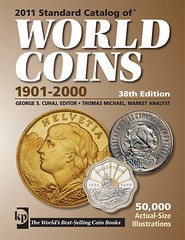 The 38th edition of the Standard Catalog of World Coins 1901-2000 is now available from Krause Publications.
The 38th edition of the Standard Catalog of World Coins 1901-2000 is now available from Krause Publications.
The new edition features nearly every world coin issued between 1901 and 2000 by more than 350 countries worldwide. In all there are nearly 1 million coins found in the pages of this authoritative and all-encompassing reference.
"While, as always, this edition reflects changes in market values worldwide, the past year has seen a dramatic increase in the price of certain coin sets, particularly from Russia and India," said market analyst Tom Michael. "We've also seen price increases from Northern European coins, and rounded out listings from the former Soviet republics."
Each coin listing in the 2,304-page reference gives readers key details for accurately and easily identifying each coin. Details including weight, mintage, issue date, actual precious metal weight, ruler at the time the coin was issued, and details about the coin's obverse and reverse images.
For more information visit
www.shopnumismaster.com/product/2011-standard
-catalog-of-world-coins-1901-2000/world-coins
.
Editor George S. Cuhaj is a 16-year veteran of Krause Publications' Numismatic Catalog Division, where he is also the editor of the Standard Catalog of World Paper Money series. Cuhaj hails from New York City, where he was previously on staff with the American Numismatic Society, Stack's Rare Coins and R.M. Smythe & Co. He is a frequent instructor at the American Numismatic Association's Summer Seminars.
Market Analyst Tom Michael serves as market analyst for Krause Publications coin catalogs, and has done so for more than 90 world and U.S. coin catalogs. He has more than 20 years of experience researching and reporting on world coin prices and market trends.
THE BOOK BAZARRE
BANKNOTE DESIGNER HARRY ECCLESTON, 1923-2010
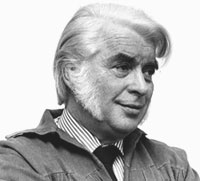 Harry Eccleston worked for more than 25 years as a banknote designer at the Bank of England and was best known for the series D notes, issued in 1978 and the first fully pictorial series. Eccleston's portrait of the Queen was on the front of the notes and his drawings of Isaac Newton (£1), the Duke of Wellington (£5), Florence Nightingale (£10), Shakespeare (£20) and Christopher Wren (£50) were on the reverse.
Harry Eccleston worked for more than 25 years as a banknote designer at the Bank of England and was best known for the series D notes, issued in 1978 and the first fully pictorial series. Eccleston's portrait of the Queen was on the front of the notes and his drawings of Isaac Newton (£1), the Duke of Wellington (£5), Florence Nightingale (£10), Shakespeare (£20) and Christopher Wren (£50) were on the reverse.
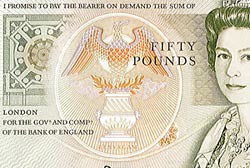 He also designed a 50-pence note bearing the figure of Sir Walter Raleigh but it was judged that, in a time of galloping inflation, the life of such a low-denomination note would be short and so a coin was minted instead. His original drawings of the Queen and of Wren were presented to her and in the same year he was appointed OBE.
He also designed a 50-pence note bearing the figure of Sir Walter Raleigh but it was judged that, in a time of galloping inflation, the life of such a low-denomination note would be short and so a coin was minted instead. His original drawings of the Queen and of Wren were presented to her and in the same year he was appointed OBE.
Subsequently, in 1958, Austin recruited Eccleston as the first artist designer to the Bank of England Printing Works, a position he held until 1983. He stayed on for three more years as a consultant until his retirement in 1986. The greater part of his time at the Bank was spent on two projects: the development of a computer engraving system to assemble notes more quickly than had been possible with previous, rather primitive, printing techniques; and, second, with Dr Ivor Stilitz, “perception research”, which was aimed at making it easier for the public to detect forgeries. “It was interesting to learn from the work how instinctively wrong one could be,” he said. “No one in the world had ever carried out such work which, of course, we gave to everyone.”
In contrast to the highly decorative work necessary for banknotes, Eccleston's output as an original artist was much more simplified. (“The nuts and bolts of seeing” was what really interested him, he said). Figures, as they appeared in his earlier pictures, are invariably still — as if standing in a frieze. The big black-and-white prints, his main works, are more minimalist and almost abstract in their austerity.
To read the complete article, see: Harry Eccleston: artist and banknote designer (www.timesonline.co.uk/tol/comment/obituaries/article7136284.ece)
The Bank was saddened to learn that Harry Eccleston, a distinguished artist and the Bank's first full-time bank note designer, died on 30th April after a long illness. He was 87.
Harry Eccleston joined the Bank in 1958 at the then recently-completed Debden Printing Works. He was recruited on the recommendation of Robert Austin who had been his college tutor and who was the designer of the 1960 £1 'C' bank note, the first Bank of England note to carry the Queen's portrait.
Harry's artistic flair combined with his down-to-earth Black Country practicality prompted one General Manager of the Printing Works to write '....he was so imbued with the technical aspects that he was able to make them the building bricks of artistic creations...' . Harry went on to become the Bank's Artist Designer, a position that was created specially for him and which he held until his retirement in 1983, although he was retained by Debden as a note design consultant for a further three years.
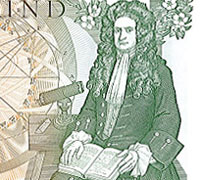 Returning to his command of design detail, the back of the 1978 £1 merits close inspection. Featuring Isaac Newton, apple blossom, the reflecting telescope, the copy of 'Principia' (open at the correct page), and machine-engraved patterns suggesting the solar system, the design also includes a triangular cross-section prism of the same proportions and size as a well-known chocolate bar.
Returning to his command of design detail, the back of the 1978 £1 merits close inspection. Featuring Isaac Newton, apple blossom, the reflecting telescope, the copy of 'Principia' (open at the correct page), and machine-engraved patterns suggesting the solar system, the design also includes a triangular cross-section prism of the same proportions and size as a well-known chocolate bar.
Certainly the prism was included for reasons of historical accuracy and rightly so, but there remains the sneaking suspicion that it could also have been a mischievous inclusion. We will never know for certain but it did prompt an executive of Toblerone to write to the then Chief Cashier thanking the Bank for the free advertising.
The Bank will always be grateful to Harry Eccleston. And his influence continues. The inspiration for the artwork in the Adam Smith £20 bank note came in part from the design of the £1 Isaac Newton note.
Harry Eccleston O.B.E. - Bank Note Designer (www.bankofengland.co.uk/banknotes/harryeccleston.htm)
NUMISMATICA MEDIEVALIS: SPECIAL FONT FOR DESCRIBING MEDIEVAL COINS
Since the readers of The E-Sylum are interested in numismatic books in general, they might also be interested in fonts used in printing numismatic publications. The Royal Numismatic Society of Belgium has set up a project for the development of a font (compatible with WORD) containing characters as they appear on medieval coins (of the regions making up the actual Belgium, but this is not to be seen as a very strict criterion).
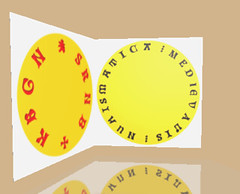
We have baptized this font for the time being Numismatica Medievalis, and have already collected or created about 2.000 signs (letters, figures, mintmarks, interpunction signs, etc.). Obviously, since at that time letters and letter punches were engraved by hand, the number of varieties of any given letter is so to say infinite, and it would be impossible to try to cover them all. Nevertheless, we are sure that some significant varieties (or new signs) are still missing, and we are seeking the cooperation of the numismatic community to help us complete the font.
For more information, and for an overview of the already available signs, please visit the website of the Society at www.numisbel.be, and click on the blinking button. Once the font will be final, it will be made available free of charge.
For more information, see: Development of a font with medieval numismatic characters (www.numisbel.be/NumisMed_GB.htm)
THE SPRING 2010 C4 NEWSLETTER PUBLISHED
- President's Message (Ray Williams)
- A Story of Misattributed Connecticut Copper (William Gleckler)
- 1787 Connecticut Obverses 32.3 and 43.2 Evolution and Characteristics (Randy Clark)
- Fugios: Are They Cents (Franklin L. Noel)
- Voices from the Past (Ray Williams)
- The Evolution of Redbook Listings for New Jersey State Coppers (James Higby)
- The Rediscovery of Connecticut 1786 5.15-S (Richard August)
- Colonial Newsletter Celebrates 50th Anniversary (Roger Siboni)
- The First Deaccessioning of Coins from the Garrett Collection (George Fuld)
- Morro Castle – Betts 443 (Marc Mayhugh)
- THE FRENCH-AMERICAN CORNER -- An Unusual 30 Deniers Coin (Jack Howes)
- The New Jersey Tea Party – 1774 (Roger Moore, M.D.)
- A Second Example of an Unusual George I Indian Peace Medal (Frank Steimle
- Muted George Speaks (John W. Louis)
- Take time for Easter (Buell Ish)
Franklin L. Noel's article on the Fugio coppers is a response to Eric Newman's recent book. He writes:
Fugios are cents. They always have been. They always will be. That's my story and I'm stickin' to it! In his recent book, United States Fugio Copper Coinage of 1787, Eric Newman suggests we adopt a new nomenclature for the Fugio coins. I respectfully disagree.
Because the Continental Congress clearly intended the Fugio coins to be cents, we should continue to call them cents. Congress required the contractor to strike the coins to “the federal standard.” Under the federal standard, 100 cents should contain 2.25 pounds of copper (157.5 grains per cent). The nominal value of the Fugio coins, as authorized by Congress, was one cent.
What makes these coins cents is the requirement that they be struck to the “federal standard.” The failure of Congress to require that the coin's name be included in the devices (as Massachusetts had done) does not make the Fugio coin a “denomination-less copper.” The only copper coins the Continental Congress ever authorized (in its August 8, 1786 Resolution) were cents and half cents. Jarvis' Fugio coins were to be struck to this “federal standard.” As the federal standard required that 100 cents consist of 2 1/4 pounds of copper, by legal definition, the coins Congress ordered Jarvis to strike were “cents.”
An article of interest to bibliophiles is James Higby's The Evolution of Redbook Listings for New Jersey State Coppers.
How to collect colonials was a question that came up again and again. As do so many of us, I scurried to the Redbook, intent upon learning everything I could about the material in that section that had been neglected for so long. There I found a somewhat methodical taxonomy and presentation that seemed understandable and workable. I use the term “somewhat” because I found some issues that could not be resolved in the light of information contained in other publications or, in a few cases, reality itself.
For example, the inclusion of a 1787 New Jersey “small planchet, plain shield” in the Redbook listings resulted in the frustration of being unable to find a truly plain shield anywhere, never mind the dozen or so slabs I had seen so labeled, but encapsulating coins that clearly showed a shield outline. The same could be said for listings for “wide shield” and “narrow shield” among the Jersey varieties. There were no specifications given for those terms, it seemed.
A series of emails with Ray Williams and Will Nipper convinced me that such terms were arbitrary and that I should devise my own scheme for classifying and collecting these wonderful old New Jersey coppers. Still, one needs to have a jumping-off place, and that place for me will always be the Redbook. What I therefore propose to do in this article is to show how the listings for New Jersey coinage started out and then evolved through sixty-three more editions of that publication.
After 64 editions of the Redbook, its New Jersey state coppers section now identifies 22 varieties. We have seen listings come and go and change. We might assume that the editors of each edition made their decisions based on a combination of collector interest, discoveries, scholarship, popularity, availability, and uniqueness.
Marc Mayhugh's article on the Morro Castle medal describes an interesting piece with a connection to Cuba, something I hadn't expected to see.
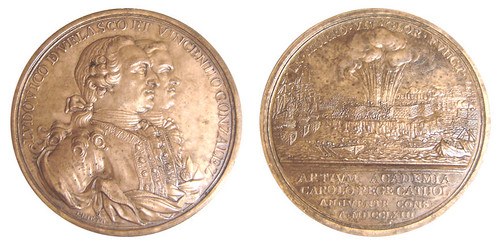
An interesting specimen in the Betts series of medals illustrating American history is Betts 443, “Capture of the Morro Castle, Havana.” These medals are located in the chapter entitled “The Period of Intercolonial Wars,” and they are unusual in that they commemorate a gallant defeat rather than a victory, unlike most of the other medals in this section. In this case, the medals are Spanish, and memorialize the two courageous commanders of Havana who lost their lives in the defense of their post, Don Luis Vincente de Velasco and Vincentio Gonzales. The commission of the medals, albeit a year after the defeat, must have taken a great deal of resolve on the part of the Spanish King who would have rankled every time he thought of losing Havana to the British, Havana being the jewel of the Caribbean, and one of Spain's most valuable possessions.
Late in the Seven Year's War, or as it was known in America, The French-Indian War, Spain became involved in a conflict which for the most part was over. The British had already expelled the French from America and had made significant gains elsewhere. The decision by the King of Spain, Charles III, normally considered a wise monarch, especially by Spanish standards, to side with France was to prove disastrous to Spanish New World holdings.
Accounts of troop strength on both sides is also conflicting, but suffice it to say the British entered the harbor and began a lengthy siege of Morro Castle.
Construction on Morro castle had begun in 1589, under the supervision of Bautista Antonelli and was finished in 1630. It served for years as a deterrent to pirates and enemy warships, yet the British attack in 1762 was not to be denied, despite horrendous losses in manpower. The siege which began in March decimated the British forces and by mid July eight thousand sailors and soldiers were suffering from various diseases and exposure to the Cuban heat. However, supplied by fresh troops from America8 and a contingent of slaves from Jamaica, the British were able to dig a mine beneath the walls of the fort and blast through them, storm the fort, and doom the defenders of Havana.
MORE ON HARZFELD'S "OLD COINS AND THEIR VALUES"
Last week I pictured this postcard sent to George W. Rode of Pittsburgh by the Philadelphia coin dealer Harzfeld and asked, "does anyone out there have a copy of this publication?"
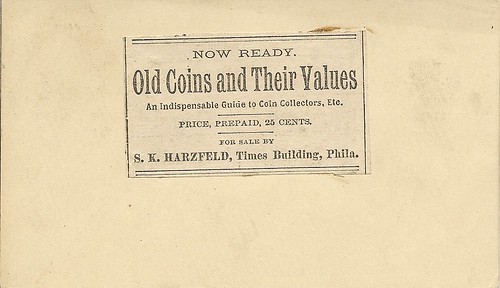
Dan Hamelberg writes:
I have several copies of Harzfeld's "Old Coins and Their Values." Basically, it is Harzfeld's fixed price list published in 1879. In part, the title page reads "Catalogue of American and Foreign, Ancient and Modern Coins, Medals, Etc. and the Prices at Which They May Be Obtained. An Indispensable Guide To Every Coin Collector." It contains 48 pages including a one page "Contents" page at the end and is priced at Twenty-Five Cents.
The preface is titled "My Business Rules" and starts with "With exception of the rare pieces, I can fill orders for any Coin or Medal in this Catalogue, at once." The list contains a limited number of American Colonial coins followed by U.S. Silver Dollars, Half Dollars, Quarter, etc.
The 1804 Dollar listing denotes "Rarest coin of the American series." It follows with a warning that "re-strikes are in existence, which have been fraudulently issued by a party connected with the Philadelphia Mint some 15 or 20 years ago."
There are listings for U.S. copper and all the minor coins to date. Under U.S. Gold, Harzfeld writes "The collecting of United States Gold is so limited, that it would be useless to publish a priced list." There are a limited number of U.S. pattern pieces listed, and some fourteen pages of various U.S. medals at fixed prices. A few pages of Foreign and Ancient Coins follow with two pages of "Special Bargain" lots at the end.
Harzfeld published several fixed priced lists before and after the 1879 "Old Coins and Their Values."
THE BOOK BAZARRE
MYSTERY NUMISMATIC ANIMAL UNVEILED
Last week Dennis Tucker wrote:
In the spirit of recent numismatic mysteries and puzzles that have appeared in The E-Sylum, here's a visual riddle: Identify this numismatic animal!

Jim Duncan writes:
It looks like an out of luck bison.
Alan Luedeking writes:
Well, if that ain't a humpbacked bison I'll be buffaloed....
Close, but not quite. Jim Downey was the first to send in the correct answer:
A dateless buffalo (nickel).
Ten minutes later, Pete Smith chimed in:
After looking for a deeper meaning, all I could come up with is a dateless Buffalo.
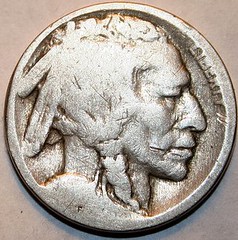 Sorry, no deeper meaning there. Also having the correct answer was
Heath MacAlpine.
Buffalo Nickels are notorious for wear on the date region – many have the date worn clean in circulation. Thanks to Dennis for sending this in.
-Editor
Sorry, no deeper meaning there. Also having the correct answer was
Heath MacAlpine.
Buffalo Nickels are notorious for wear on the date region – many have the date worn clean in circulation. Thanks to Dennis for sending this in.
-Editor
In the "Things I Learned From the Internet" department are the following tidbits which include a couple coin-related brain-teasers. I have no idea if most of these are true, but they're interesting nonetheless. These came from The Good, Clean Funnies List (see www.gcfl.net):
10. No word in the English language rhymes with month, orange, silver, or purple.
11. A duck's quack doesn't echo, and no one knows why.
20. The highest point in Pennsylvania is lower than the lowest point in Colorado.
22. If you have three quarters, four dimes, and four pennies, you have $1.19. You also have the largest amount of money in coins without being able to make change for a dollar.
27. If you put a raisin in a glass of champagne, it will keep floating to the top and sinking to the bottom.
28. Snails can sleep for three years without eating.
30. The fingerprints of koala bears are virtually indistinguishable from those of humans, so much so that they could be confused at a crime scene.
33. The Eisenhower interstate system requires that one mile in every five must be straight. These straight sections are usable as airstrips in times of war or other emergencies.
34. There are 293 ways to make change for a dollar.
MYSTERY NUMISMATIST: "YN OF THE CENTURY"
ANA Collections Manager Robin Sisler writes:
Long-time reader first-time writer... I have a great "Mystery Numismatist" for you and the other readers.
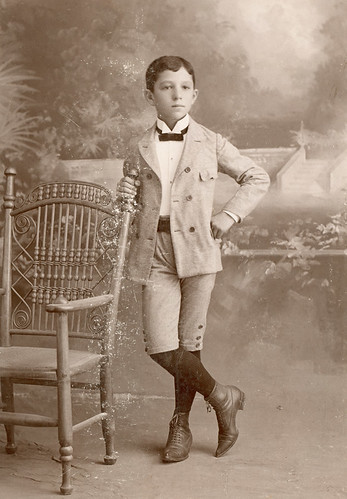
NOTES FROM E-SYLUM READERS MAY 30, 2010
Richard Doty of the Smithsonian Institution writes:
The fake t-drachm from Susa would not, hopefully, fool a four-year-old. As for Dr Bastien, I knew him; he worked with the SI collection. He was the best, and he'll be sorely missed.
Joe Boling writes:
Don't look now, but Bill Rosenblum is offering one of those Mercator map medals in his 10 June sale, lot 183. I told him to put 20x magnification on it and see if it is engraved or cast.
Philip Mernick writes:
Regarding the British Library digitising project, the article uses the abbreviation "m" many times. This is confusing (me), surely m is metres. If they mean millions I think they should use M. Whatever was intended, using abbreviations without defining them is pretty lazy writing. I would have expected better from the BBC!
Dick Hanscom writes:
The trip back East was good. We had to go down to Rhode Island for a wedding. Since almost all screw presses I have seen on eBay are in RI, I arranged to see some in hopes of purchasing one large enough to do my 1 oz. gold token.
Unfortunately, the largest they had was not large enough for my 1 oz. So, I purchased a small one just because. It should get here in a couple of weeks. I told my wife I wanted to put it in the living room, but she did not find that amusing. I believe it is a #2, stands about 6 feet tall on its table, and weighs in at about 700 pounds. I thought it would make an interesting nut cracker - put it at the end of the couch with a bowl of walnuts.
VIDEO PRESENTATIONS ON THE 1913 LIBERTY NICKEL
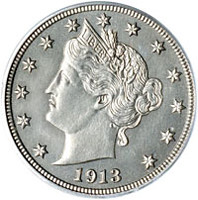
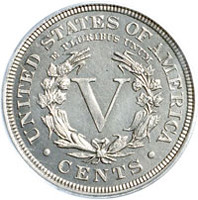
Regarding the new television program, Accidental Fortune, that includes a segment on the 1913 Walton Nickel, it might be interesting for readers to see the background of the coin's discovery from the numismatic video presentations that have been made. They are listed below.
coinvideo.com/search.php?skey=1913+Liberty&submit
Walton 1913 Liberty Nickel Reunion (2007)
Moderator Donn Pearlman, with Mark Borckardt, John Dannreuther, Beth Deisher, Bette Givens, Ryan Givens, Paul Montgomery, Ray Knight, Cheryl Myers, Gary Myers
The story of the discovery of the lost 1913 Nickel is a fascinating and still unfolding story. You will hear the story of legendary collector George Walton who owned one of the original five nickels. You will meet members of his family and hear from the numismatists and journalists who helped "rediscover" this important part of numismatics that was lost for almost 40 years. ANA07-015 Length: 110:22
Inside Story of the Discovery of 1913 Liberty Nickel (2004)
Beth Deisher, Paul Montgomery, Mark Borckardt, Donn Pearlman
Coin World editor Beth Deisher separates fact from fantasy as she tells the amazing story about the discovery of the long lost fifth and final example of this fabled American numismatic rarity. Includes commentary from Paul Montgomery, president of Bowers & Merena, who authorized a one million dollar reward for recovery of the coin, Mark Borckhardt, numismatist at Bowers & Merena, who helped authenticate the coin, and Donn Pearlman the public relations agent who helped publicise the search effort and reward. FUN04-005 Length: 74:50
Only Five 1913 Nickels? (2008)
Alvin M. Stern
Alvin L. Stern is an ASA certified numismatic appraiser. He received his accreditation in 1985 and performs a variety of numismatic services. A coin collector of 42 years, Mr. Stern researches and lectures on a number of "coin intriguing" topics. Besides his work in numismatics, he is an award-winning artist and dental technologist holding two (2) U.S. patents in mechanical dentistry.
In this lecture presentation he discusses how ninety five years ago, a clandestine scheme took place at the U.S. Mint in Philadelphia---the minting of the 1913 V Nickel. Who authorized these? Were only five (5) struck? Owned by astute collectors, millionaires and even a King, the known five coins are amongst the "jewels" of numismatic collecting. But, were there only five? You will hear information that will all you to decide including:
- The story of the search and location of a missing 1913 Liberty nickel in 2003
- Samuel W. Brown who reported struck the original nickels and his subsequent efforts to promote and sell five of them
- history and pedigree of the five known specimens
- dealer and collectors who were involved including Eric Newman, B. Max Mehl and King Farouk
- auction records that indicate there may be an additional example of the coin
- how references works in the 1940's list that six specimens were struck
- other evidence to support this theory and the research still needed
Tales of a Great American Rarity: 1913 Nickel (1993)
Robert R. Van Ryzin
Since 1920, when the hobby first learned of the existence of five examples of the 1913 Liberty head nickel, no coin has had a more colorful background. This slide-illustrated video takes a thorough look at the background, pedigree and mysterious history of these American rarities, based on research and interviews conducted by the author, a numismatic researcher and writer, who serves as managing editor of Numismatic News. ANA93-027 Length: 31:44
THE COLUMNS OF THE THIRD PHILADELPHIA MINT
Kay Olson Freeman writes:
I did not know that the six ionic columns that were on front of the 3rd Philadelphia Mint (built 1833) are now free-standing outside of Albert Einstein Hospital, North Broad St., Philadelphia. Evidently, the William Strickland designed mint building was demolished 1907 and the columns were moved to, what was then, the Jewish Hospital in 1912. Each column is all one piece of stone, not in sections. I just learned this watching a PBS TV show "A Walk on Broad Street." Maybe others knew this; but I did not.
Kay also found a couple early 1900s newspaper articles on the moving of the columns to various locations. I did not have access to the web site, so if anyone does have other information on the demolition of the third mint and the moving of the columns, let us know. Thanks. -Editor
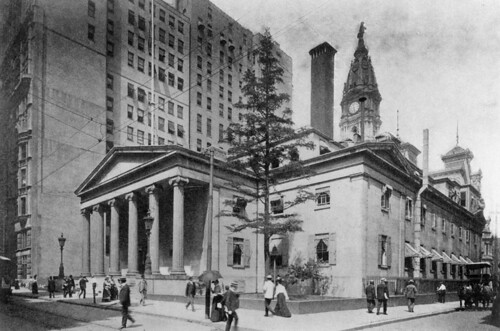
SUBSCRIBER PROFILE: HEATH MACALPINE
Heath writes:
I suspect I'm like most numismatists; I have a number of different collections underway. I've been working on a Society of Medalists collection, almost done, and I'm looking forward to the long talked about book on the subject.
I'm starting to branch into U.S. Mint medals, and would love to see a comprehensive post-Julian reference. The Medal Collectors of America (MCA) is discussing funding research; that might be a good place to start.
On the coin side, I have both a post-colonial Latin American collection and a bi-metal collection that are in hiatus, while I'm actively working on an uncirculated "one of everything" of all the issues of my birth year (1959). Many of the issues in Krause that catalog for a few bucks or less are terribly difficult to find. Finally, I'm finishing up a Bureau of Engraving souvenir card/print collection.
Regarding numismatic literature, I would like to put together a collection of Joe Levine's Presidential catalogs. He was kind enough to provide me with several of his earlier ones, but I'll need to pursue the rest somewhere else. Under the influence of the Numismatic Bibliomania Socity, I've been spending more freely on books in recent years. I don't know that I have a theme, other then my own enjoyment and edification. I'm a member of the American Numismatic Association, the Ohio Numismatic Association, NBS, and the Fly-In Club. I should probably join the American Numismatic Society as well.
I'm currently serving as President of the Dayton-Kettering Coin Club. Beth Deisher from Coin World will be presenting on Chinese Counterfeits at our meeting on Thursday, June 3. I would love to find someone to do a presentation on numismatic literature; any ideas? All E-Sylum readers in the area have an open invitation to attend our meetings. They can get with me at heathmacalpine@hotmail.com.
MORE ON HOWARD D. GIBBS
A couple weeks ago there was a reference to Howard D. Gibbs and a couple readers said they knew him. I would like to know what Gibbs did for a living, or if he was wealthy, where did his money come from?
I can add a few details about him. According to club reports in The Numismatist, Gibbs had a son named Howard Jr. Junior joined the Pittsburgh Coin Club in 1930 or 1931, but he isn't mentioned for very long. I suspect Junior didn't catch the numismatic bug.
Hans Schulman's biography of Gibbs in the first of the four Gibbs sales (October 1970 - including a photo of Gibbs in front of his vault), says he began collecting at age 7 in 1902. By 1930 Gibbs was already actively collecting cut and counterstamped coins and odd & curious currency, reportedly since about 1910 (he would have been 15 then).
Schulman says Gibbs bought the Eklund collection of copper coins, making Gibbs' collection of copper coins larger than that of Neumann (who authored a multi-volume catalog of copper coins in the 1800's). I suspect Gibbs may have had first pick, but I have heard others claim to have bought parts of the Eklund copper collection. Among these was Howard F. Bowker, who bought Eklund's cash coins.
Gibbs joined the ANA in 1917, and contributed several articles to The Numismatist, mostly on odd and curious currency, beginning in 1919. In the 1930's, Gibbs obtained an example of the Yap Island stone money by claiming to represent the Pittsburgh Numismatic Museum -- the address of which was his own home. He contacted Pennsylvania Senator David A. Reed, the senator contacted the Japanese ambassador in Washington (Yap Island was then under the control of the Japanese), and Gibbs was sent an example of the stone money -- at the expense of the Japanese Foreign Office!
There is a chapter titled "Howard Gibbs and Yap Money" in the book, "The Stone Money of Yap" by Cora Lee C. Gilliland (Smithsonian Studies in History & Technology #23, 1975).
To read the earlier E-Sylum article, see: MORE ON HOWARD GIBBS, "THE DUDE ON THE CAMEL" (www.coinbooks.org/esylum_v13n20a20.html)
HOWARD FRANKLIN BOWKER
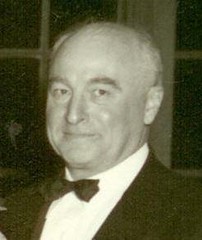 I can now reveal a secret I have been keeping since 2007. One of the foremost and most knowledgeable collectors of Chinese coins during the 1940's to 1960's was Howard Franklin Bowker, a U.S. Naval officer. Though he wrote dozens of articles, he is not as well known as his friend and correspondent, Arthur B. Coole, probably because his only published book was a bibliography of East Asian numismatics published in 1943 by the ANS.
I can now reveal a secret I have been keeping since 2007. One of the foremost and most knowledgeable collectors of Chinese coins during the 1940's to 1960's was Howard Franklin Bowker, a U.S. Naval officer. Though he wrote dozens of articles, he is not as well known as his friend and correspondent, Arthur B. Coole, probably because his only published book was a bibliography of East Asian numismatics published in 1943 by the ANS.
Coole had published a bibliography on the same subject in 1940, but Coole's work was primarily on Chinese and Japanese works, while Bowker's was on western language works. In later years, the two worked together with Kozono in Japan, and in 1967 an updated bibliography was published under all three names as volume one of Coole's Encyclopedia of Chinese Coins.
For 30 years, from the 1930's into the 1960's, Coole and Bowker corresponded, mainly about books on Chinese coins and paper money. Those letters were saved by Bowker's family and I now have copies of them (filling 3 ring-binders) in my library.
Bowker died in 1970 and in his will left his coin collection to the Smithsonian, where he had been (volunteer) curator of Asian coins in the 1950's. The Smithsonian, however, would not make arrangements to receive the collection, and not long afterwards, Bowker's wife died. The collection went to Bowker's only surviving son, Irving (his other two sons died in World War II), but still the Smithsonian would not make arrangements to receive the collection.
I heard about this in 1973 from Ward D. Smith, author of Chinese Banknotes, and a long time friend of Bowker's. In the 1980's I wrote about this collection and the Smithsonian's reluctance to accept it in my magazine, East Asia Journal, and I contacted Dr. Vladimir Clain-Stefanelli, numismatic curator at the Smithsonian, about the matter.
Dr. Stefanelli told me that they were not pushing the matter because they were afraid Bowker's son might contest the Smithsonian's claim to the collection. I visited the Smithsonian in 1994 and brought up the subject with Richard Doty (Mrs. Clain-Stefanelli who was curator then, was out of town). He had not heard about it but promised to bring it up with Mrs. Stefanelli. By this time, I had lost track of where Bowker's son was living, and the collection was lost as far as anyone knew.
In 2007, Michael Chou (Champion Hong Kong Auctions) suggested we try to find the Bowker collection. In time I was able to find Irving's widow (he had died in the 1990's), and early in 2008, Michael and I went to see the collection for the first time. For our visit, the family put up several tables in the garage, and laid out boxes and boxes of coins, all neatly filed away in Bowker's original printed envelopes. We found out that the family had contacted the Smithsonian several times about donating the collection, and the Smithsonian finally told them they were not interested in the collection. They did, however, accept the donation of Bowker's collection of Chinese stamps.
Under these circumstances, after we examined the collection for two days, Michael made the family a generous six figure offer. They were clearly shocked that it was worth so much, but Irving's widow insisted that Howard Bowker's wish that it be donated should be honored. Michael Chou offered to arrange to donate the collection to the Shanghai Museum, and Mrs. Bowker agreed, but the Shanghai Museum turned down the offer, since they already have the most extensive collection of Chinese coins in China.
Ultimately, parts of the collection were donated to the Shanghai Mint Museum, and parts to the Shenyang Finance Museum in Shenyang (formerly known as Mukden, in Manchuria). Ceremonies were held in both museums earlier this year. Details on the donations and a detailed biography of Bowker I wrote in 2008, can be found on the Champion Galleries website: www.cghka.com. The site comes up in Chinese, but if you click the ENGLISH button in the upper right, everything will appear in English.

Howard Bowker also had one of the largest libraries on Chinese coins outside of China. I was fortunate to be able to obtain most of this library, and have added it to my own. Unfortunately some books which I knew were in Bowker's library are missing. On one of our later visits with the family, we found out that when Howard Bowker died, his wife was ill and already in the hospital. Bowker's home, in Oakland, California, sat empty for some months, during which time it was broken into and robbed several times. The family has no idea what was stolen, aside from the TV's and other household items. We are all fortunate that the burglars apparently didn't think the books were worth stealing or burning.
WHERE KRAUSE NUMISMATIC PUBLICATIONS WERE PRINTED
On the way to and from a wedding this weekend, I passed through the town of Shawano, Wisconsin and this brought to mind something I heard about when I worked for Krause Publications in the mid 1970's. Krause never had its own printing presses -- everything they produced was printed somewhere else. The huge Standard Catalog of World Coins and Standard Catalog of World Paper Money were printed by R. R. Donnelley in Chicago. They print the big city telephone directories and had the only presses in the United States large enough to print such books.
If I remember correctly, the signatures were 64 pages -- that is, 64 pages were printed on one sheet, which was then folded and cut. The number of pages in the catalogs should be in multiples of 64. Coins Magazine and Coin Prices were printed in or near St. Louis. World Coin News, Numismatic News and Bank Note Reporter were printed in Shawano, in the plant which printed the local newspaper.
I toured the plant once in 1975, and if I remember correctly, they were still casting lead type for some applications. The Krause papers, however, were printed using a process in which the layout was photographed and then "burned" into large thin sheets of aluminum, from which the actual printing was done. Once the issue was printed, the sheets of aluminum were stored and eventually sold as building materials -- farmers used them as roofing for their barns! I have often wished I had saved one of those aluminum sheets as a souvenir.
THE BOOK BAZARRE
SPANHEIM'S DISSERTATIONES AND OTHER EARLY NUMISMATIC LITERATURE
Nick Graver writes:
Phil Weimerskirch, a very good librarian friend, sent this piece. He has found me some fantastic material.
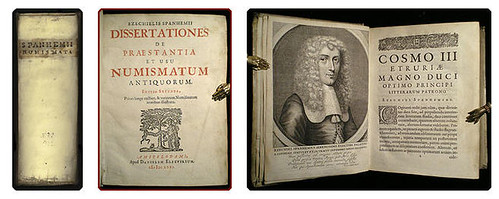
Spanheim, Ezechiel. Dissertationes de praestantia et usu numismatum antiquorum. Edition secunda, priori longe auctior, & variorum numismatum. Amstelodami: Apud Danielem Elsevirium, 1671. 4to (20.9 cm, 8.25"). Frontis., [46], 917, [51 (index)] pp.; illus.
Important treatise on ancient numismatics, written by a prominent scholar, diplomat, and collector who was one of the first to combine genuine interest in coins and medals with antiquarian erudition. This is the second edition, following the first of 1664 but more highly illustrated than that printing; the volume includes numerous in-text copper engravings depicting coins and monuments, at least one of which is signed I. Wyngaerden. The title-page is printed in red and black, with Elzevir's Minerva vignette.
For more information, see: NUMISMATICS (www.prbm.com/interest/numismatics.php)
 What I enjoyed most about these illustrations were the small metal hands holding the pages open. Neat! Where can you buy these? They'd be GREAT for displaying literature in an exhibit.
-Editor
What I enjoyed most about these illustrations were the small metal hands holding the pages open. Neat! Where can you buy these? They'd be GREAT for displaying literature in an exhibit.
-Editor
DICK HANSCOM VISITS THE NEWBURYPORT JACOB PERKINS BUILDING
Pictured in front of the building is Jay Williamson, the Historical Society of Old Newbury curator. -Editor
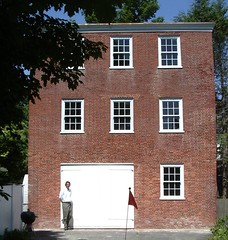
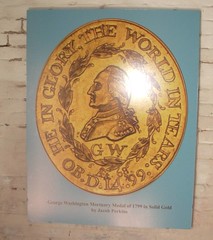
Dick writes:
The first floor historical marker was from the Massachusetts Bay tercentenary. These things were all over the state. Williamson told me this one was found, but I don't remember where.
The displays were sparse. I think they put them in just to have something other than bare walls for the grand opening (it is not open yet on a daily basis). The grand opening was only for the restoration portion of the project.
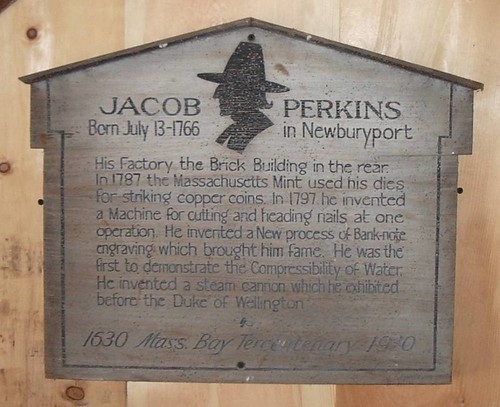
To view the slide show, see: Jacob Perkins Newburyport Building (www.flickr.com/photos/coinbooks/sets/72157624036373923/show/)
To read the earlier E-Sylum article, see: JACOBS PERKINS PRINTING AND ENGRAVING BUILDING OPENED (www.coinbooks.org/esylum_v13n21a28.html)
Dick writes:
I did not know of this until Jay Williamson mentioned it. He gave me a tour on Tuesday and I snapped some photos. The photos on the blog are better than any I took.
21ST CENTURY NATURE PRINTING: SCIENTISTS STUDY BUTTERFLIES
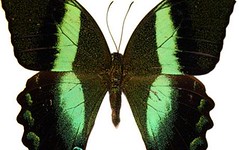 Brightly coloured patterns on the insects can now be reproduced on banknotes and passports to minimise the risk posed by fraudsters.
Brightly coloured patterns on the insects can now be reproduced on banknotes and passports to minimise the risk posed by fraudsters.
Mimicking these iridescent patterns has long eluded scientists as they are produced by light bouncing off microscopic structures in the insects' wings.
But after studying the Indonesian Peacock Swallowtail butterfly, experts at the University of Cambridge have made realistic imitation copies of the butterfly's wings.
It is due to their shape and the alternate layers of air and cuticle within the wings that they produce such depth and intensity of colour.
But scientists found a way to produce structurally identical replicas of butterfly scales.
The copies are created in the lab from a combination of nanofabrication procedures including self-assembly and atomic layer deposition.
Mathias Kolle, who led the research, said: “We have unlocked one of nature's secrets and combined this knowledge with state-of-the-art nanofabrication to mimic the intricate optical designs found in nature.
“These artificial structures could be used to encrypt information in optical signatures on banknotes or other valuable items to protect them against forgery.
To read the complete article, see:
Scientists use butterflies in fight against banknote forgery
(www.telegraph.co.uk/science/science-news/
7786619/Scientists-use-butterflies-in-fight-against-banknote-forgery.html)
PCGS TAKES AIM AT COIN DOCTORS
Professional Coin Grading Service (PCGS) today revealed additional steps it is taking to improve its ability to detect altered coins. PCGS announced that it has a process in development which will detect any foreign substance on a coin's surface, and also announced a major lawsuit filed against alleged coin doctors.
According to PCGS officials, in conjunction with the development of coin recognition technology launched in March of this year, PCGS has been developing a process to detect foreign materials and other enhancements to a coin's surfaces. Using energy dispersive X-ray spectrometry (EDX), Fournier Transform Infra-Red Spectral analysis (FT-IR), Raman Spectroscopy and other similar analytical techniques, this detection process (code-named by PCGS the PCGS Coin Sniffer™) will analyze the surfaces of a coin in a matter of seconds to detect foreign substances and provide quantitative information about the coin.
"Coin doctors" often apply numerous materials to the surfaces of coins to conceal problems with the coin, and/or alter the surfaces to improve its appearance in an attempt to artificially increase its value. The simultaneous alloy determination will further aid in the detection of counterfeits as an additional benefit.
Additionally, Collectors Universe, Inc. (NASDAQ: CLCT), the parent company of the PCGS, has filed a Federal Court suit in United States District Court, Central District of California, against several individuals claiming they engaged in a pattern of racketeering activity, breach of contract, conspiracy, unfair competition and fraud for allegedly submitting 'doctored' coins to PCGS for grading on multiple occasions for a period of years.
The suit claims the dealers violated federal laws, including the Lanham Act involving interstate commerce and RICO racketeering statutes, and also alleges "unlawful, unfair and fraudulent business practices" for submitting coins that were deceptively altered in an attempt to increase their value.
 The Complaint states: "Defendants knew that these coins had been 'doctored,' by themselves and/or other persons engaged by them for that purpose. Their methods included lasering the surfaces of extremely rare proof gold coins to remove surface imperfections, building up commonly-worn or weakly-struck portions of coins, and other physical and chemical processes. Defendants represented to PCGS that these coins had natural surfaces, intending to deceive PCGS's graders so that the 'doctored' coins would be certified by PCGS and then sold in the rare coin marketplace."
The Complaint states: "Defendants knew that these coins had been 'doctored,' by themselves and/or other persons engaged by them for that purpose. Their methods included lasering the surfaces of extremely rare proof gold coins to remove surface imperfections, building up commonly-worn or weakly-struck portions of coins, and other physical and chemical processes. Defendants represented to PCGS that these coins had natural surfaces, intending to deceive PCGS's graders so that the 'doctored' coins would be certified by PCGS and then sold in the rare coin marketplace."
This detail image of a "doctored" Standing Liberty quarter shows the decomposition of soft metal that was applied to the coin and shaped, apparently with a jeweler's engraving tool, to simulate a "Full Head." (Photo by PCGS.)
Some of the dealers are demanding the return of their coins, but the plaintiff says they're holding on to them as evidence; the suit also calls for the defendants to "be ordered to deliver for destruction all "doctored" coins in their possession which have been placed in PCGS holders". Here's a quote from the filing describing the types of alleged "doctoring". -Editor
Defendants knew that these coins had been "doctored", by themselves and/or by other persons engaged by them for that purpose. Their methods included lasering the surfaces of extremely rare proof gold coins to remove surface imperfections, building up commonly-worn or weakly-struck portions of coins with exotic metals, and other physical and chemical processes.
To read the complete press release, see: PCGS Announces Next Steps to Improve and Protect Hobby (www.pcgs.com/articles/article_view.chtml?artid=6237&universeid=313)
To read a copy of the lawsuit hosted by CoinLink, see: www.coinlink.com/News/pdf/CU_vs_Coin_doctors.pdf
NEW NONDESTRUCTIVE METHOD FOR ANALYZING ANCIENT COINS
 Demonstrating that chemistry sometimes can inform history, researchers from the National Institute of Standards and Technology (NIST), Colorado College and Mount Saint Mary's University in Emmitsburg, Md., have shown that sensitive nondestructive evaluation (NDE) techniques can be used to determine the elemental composition of ancient coins, even coins that generally have been considered too corroded for such methods.
Demonstrating that chemistry sometimes can inform history, researchers from the National Institute of Standards and Technology (NIST), Colorado College and Mount Saint Mary's University in Emmitsburg, Md., have shown that sensitive nondestructive evaluation (NDE) techniques can be used to determine the elemental composition of ancient coins, even coins that generally have been considered too corroded for such methods.
Along the way, the researchers' analysis of coins minted in ancient Judea has raised new questions about who ruled the area while giving insight into trading patterns and industry in the region.
Elemental and isotope analysis of the metals in ancient artifacts sometimes can pinpoint the places where the metal was mined, because ores in a given region often have a unique composition. This can be combined with historical records of when mines in the area were operating to determine when the coin was likely struck. The results not only help date the coin, but also offer insight into trade and power relationships in the region.
To read the complete article, see: Nondestructive Methods for Evaluating Ancient Coins Could Be Worth Their Weight in Gold (www.sciencedaily.com/releases/2010/05/100527124053.htm)
FINEST 1794 DOLLAR SALE PUBLICITY
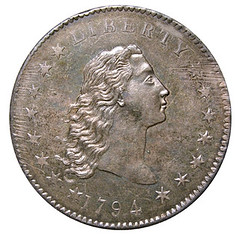 It was an extraordinary week for rare coins and stamps, with two of the world's most valuable specimens being sold within days of each other.
It was an extraordinary week for rare coins and stamps, with two of the world's most valuable specimens being sold within days of each other.
If anyone doubts the enduring appeal of American currency, a sale completed Thursday of a sparkling 1794 silver dollar should put that to rest. The coin, believed by some experts to be the first United States dollar ever minted, was sold to a nonprofit educational group for $7.85 million, a world record for any coin.
“This is a national treasure,” said the seller, Steven L. Contursi, a California coin dealer who has owned it since 2003. He has exhibited it at a museum in Colorado and at collector events. The buyer, the Cardinal Collection Educational Foundation, is expected to continue publicizing the coin.
Silver coins up to a dollar were authorized by Congress partly to show off the young nation's economic prowess. Of the 1,578 dollars made that first year, all by hand presses, about 140 have survived. This coin is considered the finest of them, with crisp, lustrous details still visible on the allegorical Lady Liberty's flowing hair. What appear to be heavy scratches across the coin are actually file marks, made when the coin was struck to ensure its weight in silver was precise.
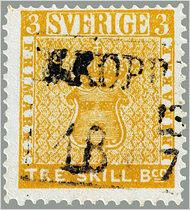 On Saturday, the world's most valuable stamp changed hands. The sale, in a secretive auction in Geneva, was between unidentified parties for an undisclosed amount. The auctioneer, David Feldman, would say only that the buyer was an international consortium and that the seller was a financial firm auctioning the stamp to collect on a debt by its former owner. “The consignor was very pleased” with the result, he said.
On Saturday, the world's most valuable stamp changed hands. The sale, in a secretive auction in Geneva, was between unidentified parties for an undisclosed amount. The auctioneer, David Feldman, would say only that the buyer was an international consortium and that the seller was a financial firm auctioning the stamp to collect on a debt by its former owner. “The consignor was very pleased” with the result, he said.
The Swedish stamp of 1857, accidentally printed in yellow instead of green, became the world's most valuable in the 1990s, in a series of record-setting sales approaching $2.5 million.
The stamp has a glamorous past. The only one of its type ever discovered, it was found by a Swedish schoolboy in 1885, later seized by the French government as reparations after World War I and has since belonged to famous collectors including the king of Romania.
To read the complete article, see: $7.85 Million for U.S. Coin, and Extra for a Stamp (www.nytimes.com/2010/05/24/us/24record.html)
We knew it was a matter of time before something like this would happen. You had a hungry collector with funds who cherished a unique coin. He didn't really have many choices for the date. So it was matter of passing or paying the price. We do know for a fact, there were at least TWO other seriously interested collectors as well who wanted to own it. The new owner simply paid more than the others.
For those who feel the price is extreme, we do not. The coin is unique, high quality, and wildly historical. There is nothing else like it. We strongly believe should the new owner have the long term holding power, when sold, this coin will yet again break all pricing records.
Also, we strongly believe within the next year, the $10,000,000.00 price barrier will be broken. There are two coins that will easily do it when they come to market (not if-Legend has made an offer on one for much more).
Having a gigantic sale that creates a record price just adds to consumer confidence in the high end market. The DOES trickle down to ALL levels as well (I'm sure we'll read on the chatrooms how the typical eBay buyer does not care-but it does affect them). Collectors love auctions because they believe they were only one bid on top of someone else's. In this case, buyers of the rarest coins like seeing the highest levels have activity and move up in value.
To read the complete article, see: Legend Numismatics Market Report (www.coinlink.com/News/us-coins/legend-numismatics-market-report/)
 Two major studies on the elusive 1794 dollar, one by Jack Collins, the other by Martin Logies, each agree that the coin is the top of the condition census. Some earlier remarks by catalogers who handled it as well as the Lord St. Oswald specimen, acquired at the Philadelphia Mint in the fall of 1794, lean toward the other as superior.
Two major studies on the elusive 1794 dollar, one by Jack Collins, the other by Martin Logies, each agree that the coin is the top of the condition census. Some earlier remarks by catalogers who handled it as well as the Lord St. Oswald specimen, acquired at the Philadelphia Mint in the fall of 1794, lean toward the other as superior.
In any case, the test of which grade is the greater is measured in infinitesimal calibrations – and the one owned by Steve Contursi (and formerly Amon Carter, Jr.) – makes the case for a spectacular history that goes back more than 60 years, and in the process shows how a true rarity has fared.
The coin that broke all prior records – including the previous high of $7.59 million for the King Farouk specimen of the 1933 $20 gold piece – makes its first modern appearance when Col. E.H.R. Green's collection was acquired by Burdette G. Johnson and the St. Louis Stamp & Coin Company.
It's not every day that a major rarity is sold, and it doesn't always go up. The Neil-Carter-Contursi coin's next auction appearance was in 1986 at the Hoagy Carmichael sale by Superior, where Anthony Terranova was the buyer at $209,000. It then evidently passed through several familiar hands: Ed Milas and Marvin Browder (for RARCOA), Andy Lustig (1988) at $375,000, and in 1991, Superior's May, 1991 sale of “An Amazing Collection of U.S. Silver Dollars,” where it brought $506,000.
There were some intervening owners including Jay Parrino, but it is Steve Contursi who held it for the last several years, when he finally agreed to sell it to the Cardinal Educational Collection at $7,850,000.
All told, the Mint records show that 1,758 silver dollars were made in the first year of manufacture. About 120-140 specimens are known today, and ironically, it turned out that another of this early silver dollar date became the first rarity to cross the Rubicon of an auction where a single coin received a $100,000 bid.
To read the complete article, see: Price Jumps for 1794 Silver Dollar (numismaster.com/ta/numis/Article.jsp?ArticleId=10894)
DENVER TOUR HIGHLIGHTS 1922 U.S. MINT ROBBERY
I'VE been recruited to help solve one of Denver's most notorious crimes. On December 18, 1922, a Federal Reserve Bank delivery truck was being loaded with money outside the Denver Mint when three men pulled up in a black Buick and jumped out, firing sawn-off shotguns. Fifty guards returned fire but the robbers still managed to get away with $US200,000. One of them, Nicholas Trainor, was killed in the gunfight but the two others were never identified.
The case remained unsolved for 12 years until the Denver police suddenly announced they'd worked out who was responsible. Conveniently, all the gang members had either since been killed or were already in prison.
No one was ever charged in relation to the crime and the case was officially closed on December 1, 1934.
Today, we've been instructed to be at the entrance to platform two in Denver's impressive Union Station at 10am. Just as the clock ticks over the hour, an agitated-looking woman comes clattering down the underpass wearing a 1920s-style blue sequin dress and carrying a battered brown suitcase.
She explains that she is Mrs Florence Thompson, girlfriend of Nicholas Trainor, and that she never got her share of the loot. Of the $200,000 that was stolen, only $80,000 was recovered by police, so she wants us to track down local hoodlum Tommy Bell to help trace the rest of the cash.
Someone asks her what's in it for us. "I don't shoot you," she replies, quick as a flash, before handing us our first clue and disappearing back up the underpass. "And remember now," she shouts back, "no lollygagging around."
And so begins a Denver walking tour with a difference. The first clue directs us to the city's LoDo (Lower Downtown) district, a fashionable area near Union Station that has been revitalised with cafes, restaurants and bars. We've been told to find a renowned independent bookstore and then track down a copy of a book on the robbery that will contain our next clue to the mystery.
Other clues have us rummaging behind rubbish bins and water fountains, unravelling coded messages and even approaching a so-called "tourist" to take our picture (the clue is on her camera - just don't tell anyone I told you).
Along the way we get to check out many of Denver's famous sights: the mint where the robbery took place; the impressive Colorado State Capitol Building (which is exactly one mile (1.6 kilometres) above sea level, hence Denver's nickname of the Mile High City); the Denver Performing Arts Complex (the second-largest performing arts centre in the world) and the Colorado Convention Centre, which, bizarrely, has a 12-metre-tall sculpture of a blue bear outside.
What really brings this tour to life are the characters you meet along the way. Outside the mint, we come across Paul Clar, a Denver Express reporter who was a witness to the crime. He regales us with the gory details of what happened on that fateful December day and points out the bullet holes that are still in the mint's stonework. We also meet the "ghost" of Nicholas Trainor, who reveals what happened after the robbery, and an FBI agent, who tells us of the struggles police had tracking down the suspects.
The intriguing part is that we never know where we're going next or who we're going to meet. On several occasions, we find ourselves eyeing someone innocently sitting in a park or lingering on a street corner, thinking that he or she is our next clue.
Ensuring all the clues are where they need to be and that everyone is in the right place at the right time must be a logistical nightmare but the tour is executed flawlessly. It's one of the most ingenious city tours I've come across and, by the end of it, we've covered not only many of the city's main sights but we've also learnt a fair bit about its history.
Of course, the big question is what happened to Mrs Thompson? Did she track down Tommy Bell? Did she get her share of the loot?
That's not for me to say. But if you find yourself near platform two on Denver's Union Station at 10am, there might just be someone there who knows.
To read the complete article, see: Case of the Mile High mystery (www.smh.com.au/travel/case-of-the-mile-high-mystery-20100520-vhqx.html)
To read an earlier E-Sylum article, see: OLD HARVE BAILEY CAPTURED (www.coinbooks.org/esylum_v08n35a14.html)
ARTICLES DISCUSS ABOLISHING THE CANADIAN CENT
Financial columns in Canadian newspapers across the country carried articles this week about the dialog Wednesday in Canadian Parliament to abolish the cent as a circulating coin.
Some of the best language has been written about the pros and cons. The strongest reason in favor is the $100 million savings in not minting 500 million new cents each year. Plus the labor and transportation costs of placing these coins in circulation. Also the explanation of rounding off to the nearest five cents was published in crystal clear language.
One of the reasons against is the one-time cost of inaugurating such a plan. I presume this would be the cost of a publicity program informing the citizens they no longer had to carry cent coins in their pockets and purses. Plus the fact any inherent cost for all their cash purchases would balance out overall, were they might lose a cent in one transaction and make it up in another.
One quote stated: "There are an estimated 30 billion pennies in circulation in Canada, more than 600 for every man, woman and child in the country."
The cent coins would be retired, ultimately to be melted for the value of the metal, now worth more than $1.50 for every 100 coins. All Canadian cents dated 1999 and prior are a copper and zinc composition. These coins, when melted, could easily be reformulated into BRASS. Perhaps this would flood the market for brass causing a dip in the price for that metal for a brief time. So the retirement of the coins should be casual -- perhaps stretched out over ten years -- rather than an immediate recall of all cent coins.
All Canadian cents dated 2000 and later are a copper coated steel. This will prove to be an interesting scrap technology. I am certain, however, Canadians are ingenious to devise the methodology of separating the metals from the alloy of melted coins.
Long run: benefit to all Canadians, with tremendous cost savings.
One Canadian Senator summed it up: "The penny has outlived its usefulness. It is, in fact, a piece of currency that lacks currency."
The same savings multiplied many fold could be applied to United States as well, by eliminating its cent coins. Are you listening U.S.Treasury and Mint officials? Don't make a plastic or aluminum penny. Abolish the cent!
The best -- among dozens of the articles this week -- is by Philip Lang of Canwest News:
www.montrealgazette.com/business/Kill+penny+save+millions
/3075436/story.html
A more lengthy, but highly informative article was written by Kim Covert: www.vancouversun.com/news/penny+drops/3085440/story.html
Here is the table of Canadian Cent composition from Wikipedia:
Composition throughout history
Years Mass Diameter/Shape Composition
2000–present * 2.35 g 19.05 mm, round 94% steel, 1.5% nickel, 4.5% copper plated zinc
1997–1999 * 2.25 g 19.05 mm, round 98.4% zinc, 1.6% copper plating
1982–1996 2.5 g 19.1 mm, 12-sided 98% copper, 1.75% tin, 0.25% zinc
1980–1981 2.8 g 19.0 mm, round 98% copper, 1.75% tin, 0.25% zinc
1978–1979 3.24 g 19.05 mm, round 98% copper, 1.75% tin, 0.25% zinc
1942–1977 3.24 g 19.05 mm, round 98% copper, 0.5% tin, 1.5% zinc
1920–1941 3.24 g 19.05 mm, round 95.5% copper, 3% tin, 1.5% zinc
1876–1920 5.67 g 25.4 mm, round 95.5% copper, 3% tin, 1.5% zinc
1858–1859 4.54 g 25.4 mm, round 95% copper, 4% tin, 1% zinc
Although the RCM states 2000 as the year of transition from zinc to steel, collectors have reported finding zinc cents dated as late as 2006 in circulation, while steel cents dated before 2002 are rare in circulation.
From May 2006 to October 2008, all circulation Canadian pennies from 1942 to 1996 had an intrinsic value of over $0.02 CAD based on the increasing spot price of copper in the commodity markets. The break-even price for a 2.8 g solid copper penny is $1.61 USD/lb, with prices during this period reaching as high as $4 USD/lb.
ARTICLE: CHINESE COUNTERFEITS PEDDLED AT LOCAL COIN SHOW
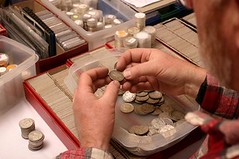 A rare-coin dealer is suspected of selling counterfeit coins at a collectibles show at the Antique Warehouse, 1122 Tittabawassee in Kochville Township, held on May 15, State Police Detective Sgt. Gary L. Thomas of the Bridgeport Post says.
A rare-coin dealer is suspected of selling counterfeit coins at a collectibles show at the Antique Warehouse, 1122 Tittabawassee in Kochville Township, held on May 15, State Police Detective Sgt. Gary L. Thomas of the Bridgeport Post says.
“The person that purchased these started to think about how good a deal he got on some of these coins,” Thomas said. The buyer took the coins to an area coin dealer who “advised him that most likely they were counterfeit.”
Thomas said the coins did not weigh what they should have based on the type of metals used to mint the originals.
“Most of these coins appeared to have been circulated,” Thomas said. “They looked like they were of the correct era, but evidently these coins are being manufactured in China.”
Sight alone could not identify the coins as fakes, Thomas said.
He said the victim paid several thousand dollars for some of the coins, which if original, are valued at several hundred thousand dollars.
Thomas said no arrests have been made and the case may be turned over to the Secret Service because it involves U.S. Currency.
To read the complete article, see:
Rare coin dealer suspected of selling counterfeit coins in Kochville Township
(www.mlive.com/news/saginaw/index.ssf/2010/05/
rare_coin_dealer_suspected_of.html)
READER NOTES ON CHINESE COUNTERFEITS
It was really great that you published scenes from the "Chinese mint" which makes all the counterfeits in the last issue of The E-Sylum. I think copies should be sent to the Secret Service, Federal Trade Commission, Commerce Commission, all the newspapers including the New York Times, Wall Street Journal and Washington Post as well as all coin publications, the Professional Numismatists Guild, the American Numismatic Association, and the American Numismatic Society.
These images show what exists and what we all are facing. Though your circulation is small, it is important that all this has been shown. This is a great piece of evidence which could make a dent in the heads of the officials who don't care about how a market can be diluted and hurt.
Someone might consider also trying to reach Michael Castle of Delaware at the House of Representatives to give this a push.
To read Harvey's Stack's pleas for regulation in this area, see: HARVEY STACK: ACTION NEEDED AGAINST COIN FAKES AND REPRODUCTIONS (www.coinbooks.org/esylum_v13n20a29.html)
Coin World editor Beth Deisher writes:
Most of the images posted from About.com/coins were published in Coin World in December of 2008. They and a 3-part series about Chinese counterfeits are posted on our web site under Reference/Chinese Counterfeits. They are NOT behind our firewall. They have been available, free to everyone since publication. Here's the link to the first in the series http://www.coinworld.com/articles/ChineseCounterfeit/Part1.aspx
I'm not sure why Susan re-posted this material again at her site. It is essentially almost three years old. Nor was the interview with Fred Weinberg new. I talked with Fred after reading the E-Sylum last week. He hasn't talked with Susan in more than a year. He was surprised also to see it presented as NEW information.
However, regardless of when published, if it helps to inform people about what's going on, so much the better.
BTW, the images (with the exception of the China Mint and Fred) were provided by the counterfeiter interviewed in our articles.
Ron Ward writes:
I especially enjoyed the section on Chinese fakes. Take a look at eBay #300428034647, 100 PCGS 1909 P VDB MS-67 - MS62, 2 rolls, 100 pieces - starting bid $9999.00 Something obviously very wrong. This dealer has no other coins listed. Today on eBay I noticed that several Chinese dealers are selling BU 1909-S VDBs labeled COPY starting bid 10 cents each. I think they are not only counterfeiting the coins but also PCGS holders.
To view last week's images of Chinese counterfeiting operations, see: CHINESE COUNTERFEIT COIN DIES, MINTING MACHINERY, AND FAKE COINS (www.coinbooks.org/esylum_v13n21a26.html)
Gar Travis sent this link to a web site offering copies of rare U.S. coins including 1870-CC Seated Dollars, 1877-S Trade Dollars, 1874-S $10 Golds, 1875-CC Trade Dollars, and 1871-CC Liberty Seated Dimes. Buyers can choose examples with or without the word REPLICA or COPY.
I have the largest coin plant in China. I have lots of kinds of coins. I can provide about 2000 kinds of different coins.
Jinghuashei Coins (www.jinghuashei.com/)
FEATURED WEB SITE: COIN SHRINKING
This week's Featured Web Site is suggested by Kavan Ratnatunga, who came across it while searching for other things. David Fanning introduced the topic to us in 2006, and Coin World had articles on it as early as 2002. It's a neat little scientific demonstration - check out some of the videos on the site.
NOTE! The information on this site is for educational purposes only. It is not to be construed as advice on how to build or use similar equipment. Electromagnetic Forming is an extremely dangerous high-energy process that can maim or kill a casual HV experimenter!
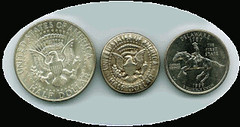
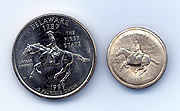
The Quarter Shrinker utilizes a technology called high velocity electromagnetic forming, or "Magneforming". To shrink coins, I charge up a large high voltage capacitor bank consisting of a number of large "energy discharge" capacitors. Applying a 6,300 joule pulse results in a quarter whose final diameter is about 0.1" SMALLER than a dime! The largest coin I've shrunk was a Silver Eagle, a silver coin that starts out being about 1.6" in diameter, and ends up 1.3" in diameter afterward. At 6,300 joules, a Morgan silver dollar is reduced from about 1.5" to 1.25" in diameter, and a clad Kennedy half dollar is reduced to a diameter smaller than a US Quarter.
capturedlightning.com/frames/shrinker.html

